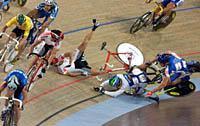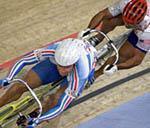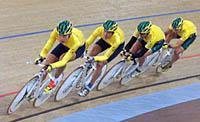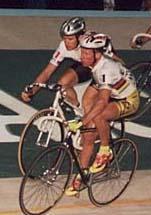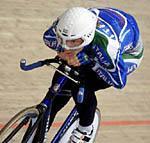|
An Introduction to - Track Cycling An overview of track racingBy Jeff Jones and John Stevenson Background
The first track racing world championships was held in 1895. Early track races included bizarre high-speed events in which riders slipstreamed four-and six-man pace bikes. These were replaced by motorbikes after the turn of the century, and 'Derny' racing still plays a part in some European six-day festivals. Currently the top track nation is France, closely followed by Germany, with Australia and Great Britain in the next tier. In addition, the USA, Spain, Switzerland, Russia and Belgium have several standout riders or teams.
Velodromes can range from less than 200 metres (with very steep banking) to over 450 metres on outdoor, concrete tracks. However, Olympic standard velodromes need to be 250 metres in length, completely covered, and made of wood. Wooden velodromes need to be hard, straight and hold their shapes as they age. For this reason, most are built from Baltic Pine which often comes from a plantation in Finland that has supplied virtually every recently built velodrome. A 250 metre track has 60km of 40mm x 40mm x 6m planks and is held together by 360,000 nails. Track surfaces last for decades, and get better as they get older: as the wood hardens the track gets faster. The area infield of the track accommodates team support staff such as coaches, managers, mechanics, and masseurs; the press; officials and timing and in the case of the track at Atlanta, event office space. Offices are usually underground, but the Atlanta track was temporary so no no underground facilities were dug. The Atlanta track was sold after the 1996 Games and is now part of Los Angeles Disneyland. Track bikes are minimalist. There are no brakes, no gears and no freewheel; if the back wheel is turning, so are the pedals. Speed is controlled by pedalling and by pushing back on the moving pedals. Match sprint and points race bikes are usually made of simple steel tubes; they're strong and cheap and their poor aerodynamics don't really matter. A good one costs about $2,000. Pursuit bikes are the exotic carbon wheeled fish everyone gets excited about. The development budget for Brian Hayes' Australian Superbike project stands at $1.4 million. Disc wheels are used for aerodynamic reasons even though they are heavier, weaker and far more expensive than wire spoked wheels. Front discs are only used indoors as the slightest breeze sends a bike with one blowing up the track. Three and four spoke wheels have most of the aerodynamic advantages of discs without the problem of instability in a sidewind and are therefore commonly used up front. Track bikes use one-piece tyre and tube assemblies called 'tubulars' or 'singles' that are glued on to the rim. A very thin, smooth rubber tread covers a silk tyre case holding 150-200psi of pressure. Riders are firmly attached to the bikes using step-in pedal systems, or standard pedals with two sets of straps. It's vital that riders can't accidentally pull out of the pedals, and that power transfer be as efficient as possible, so riders use shoes with extremely stiff soles. Over the years many pedal and shoe systems have been tried, including ones that build the pedal axle and bearings into the sole, so the rider has to be laced into the bike. Probably the greatest stuff-up in recent track racing history was Shane Kelly pulling out of the pedals at the start of the Atlanta Olympics 1,000m sprint. Kelly was using pedals with straps and believes he simply failed to prepare properly and tighten them hard enough. One-piece Lycra skinsuits are standard dress. They're skin-tight, aerodynamic and don't impede pedalling. Rubberised surfaces and other coatings have been tried to improve aerodynamics, but don't seem to make enough difference to justify the cost and sweatiness. Hard helmets have replaced the old-style leather strips, which were as much use as a curly perm if you crashed. Some helmets - known as 'sperm hats' - are shaped to improve airflow over the back of the head. Gloves are essential protection against a palm full of splinters if you crash.
Track racing is aggressive and crashes are common, but rarely serious. One of the worst in recent Australian racing was Craig Milton's now legendary spill in Launceston in 1985. Milton went down when a tyre blew out on him, and as he landed his pedal dug up a splinter of the then-new track surface. A 33cm long, 1cm wide spike entered his torso just under the armpit, puncturing his lung and stopping 1cm from his heart. The spike had to be broken off the track surface so Milton could be removed and he spent 8 hours under the knife as surgeons pulled bits of wood out of the wound. Milton got back on the bike a week later to win the Australian 10 mile and team pursuit championships. His effort in the team pursuit tore open the stitches and he finished the event with his blue NSW track squad strip dyed red, and had to immediately return to hospital. The spike is on display in his bike shop in Cronulla. Track racers need excellent fitness, usually expressed as a high VO2 Max measurement which indicates the rider's ability to use oxygen efficiently. Sprinters need lots of 'fast-twitch' muscle fibres, and one coach was famous for refusing to even look at riders who can't jump to reach a point a certain distance above them. The hugely-muscled aerobic animals that infested sprinting in the 80s are less common now, though, because sprinters typically have to do slightly longer events as well, and so cannot afford the extra mass that comes from training specifically to go like a nutter over 200m. The EventsWhile this doesn't cover the complete variation of track disciplines, most are covered and can be broadly classified into "sprint" and "endurance" events. For the newcomer to the sport, or even experienced observers, certain track cycling events can be a complete mystery. The following is a potted description of the races. Sprint events Match Sprint (Men/Women)
Traditionally held over 1000m, this event captures the essence of track cycling, although it is the most mysterious. Although it is normally a one-on-one event, earlier rounds can feature three or more cyclists on the track at the same time. One rider is designated to lead for the first lap (usually by a coin toss), and can not relinquish it unless those behind take it from him/her. The competitors typically eye each other off for the first 6-700 metres, trying to maneuver each other into an unfavourable position, before launching an explosive sprint for the last 200 metres, which is the only part of the event that is timed. The first across the line wins the race. Tactics are the key to this race, and many people wonder why it is so slow for the first two laps. The main reason is that unless you can surprise your opponent early, you will waste too much precious energy in starting your sprint from lap one. If the other guy is on your wheel, it's all over. An important rule is that of 'possession' underneath the sprinter's line, a line marked 80 cm from the pole line near the base of the track. A rider who positions themselves below this line in the final 200 metres is not allowed to be forced out by another rider e.g. pushing in from the inside. This is one of the most often broken rules causing reversals in sprint results. 1,000 m Time Trial (Men) Probably the most painful of track disciplines, the "kilo" as it is known commonly is raced as a time trial over 1000 metres. To do well in this event you have to have an explosive start, good top speed, and endurance to carry you through the last few hundred metres where the lactic acid buildup in your legs becomes almost intolerable. The current record is just over a minute, held by Arnaud Tournant of France. In this event, two riders often start on opposite sides of the track although it is essentially an individual event. 500 m Time Trial (Women) Held over half the distance of the men, the women's 500m time trial requires explosiveness as well as good top speed. Typically, the fastest 200m rider is also the best over 500, although this is not always the case. It is different to the men's race with respect to the endurance required. Olympic Sprint (Men)
A three man time trial held over three laps of the velodrome, with teams starting on opposite sides of the track. After the end of each lap, the leading rider pulls off completely, leaving the next to fight the wind. Therefore, the first rider has to do one laps, the second, two laps, and the last rider three laps. Hence, rider number three typically has the best endurance: A good kilometre time trial rider e.g. Arnaud Tournant or Shane Kelly is chosen for this position. 2000 m Keirin (Men) The keirin is a motorpaced event that is very popular in Japan where it originated. In that country, huge amounts of money are bet on races and professional keirin riders command impressive salaries. It is similar to the match sprint, but features 6-8 riders on the track. A derny motorbike paces the riders from 25 km/h up to 45 km/h for the first few laps. During this time, riders jostle each other for the best position and this is often the roughest part of the event. With two and a half laps to go, the derny bike pulls off and the sprint is on. Team tactics are important here, as the leadout is often quite long. If one team can get two of their riders in the final, then they are at a distinct advantage. Endurance events Individual Pursuit (Men/women) Held over 4000 metres for elite men and 3000 metres for elite women (shorter for masters riders), this is considered an "endurance" track event, although the speeds are still extremely high. Two riders start on opposite sides of the track and try to set the fastest time over the allotted distance. Normally, a qualifying time trial is ridden that determines who is eligible for the semi finals and finals. The fastest ride is often produced here, as in the finals, the only important criterion is to beat your opponent. If one rider catches the other, i.e. puts half a lap into them, then the race is over. An explosive start is not critical (but it's handy to have), however the ability to ride at a consistently high speed is far more important. Many riders who go out too hard can look to be well up on their opponent, only to fade in the last 1000 metres. This has typically the greatest "cross-over" to the road. i.e. good pursuiters make good road riders and vice versa. Stuart O'Grady, Vjatcheslav Ekimov, and Chris Boardman are a few examples of top pursuiters who have had successful road careers. 4000 m Team Pursuit (Men)
This event is raced by the men only, and held over 4000 m. Faster than the individual pursuit, although it is still an endurance event, the team pursuit is about clockwork precision as well as high speed. Two four man teams start on opposite sides of the track and try to set the fastest time over the distance as with the individual pursuit. The time taken is on the third rider to cross the line. Riders must follow each other at a few cm difference to gain the maximum drafting effect from the rider in front. Following a wheel closely is a vital skill, but stuff-ups still happen, as the Ukrainian team showed at the 1997 Worlds in Perth. A wheel touch in the final brought down the whole team down and cost them the event. Turns of pace are often half a lap, although the stronger riders can do full lap turns. The world record for this event was set by Germany in 2000 and is over 60 km/h! 60 km Madison (Men)
This race is named after Madison Square Garden in New York where the event was first held (also called "Americaine" in French. Two man teams contest the event, which is typically 50-60 kilometres. After a mass start where all riders are on the track, only one rider from each team is allowed in the race at a given time, meaning that teams must take it in turn each lap (or more) to have a rider in the race. Changeovers are quite dangerous, but impressive to watch when done well - one rider circles around waiting for his teammate, who joins hands and imparts his momentum to the slower rider. To win the madison, the team must score points by sprinting every 20 laps for bonuses (5, 3, 2, 1 points). The last lap counts for double points, but the winner of this does not necessarily win the event. Also, if a team can gain a lap on the field, then they are in the leading position of the race no matter how many points they have. Points Race (Men/women) This is a solo event, scored similarly to the madison and raced by both men and women. Again, a rider scores points in intermediate bonus sprints every 10th lap (5, 3, 2, 1) with double points awarded on the last lap. If a rider can lap the field, then they win the race. The Hour Record (Men/women)
One track event stands outside and above typical track events: the hour record. This is a simple test of ability to cover distance in 60 minutes and both UCI and Absolute records are currently held by Brit Chris Boardman. In 1996, Boardman rode 56.375 kilometres around Manchester velodrome using the now outlawed "superman position". In October 2000, he rode 49.441 kilometres on a UCI standardised bike: a steel tubed triangular frame with spoked wheels and no aero helmet. Traditionally, only great riders at the peak of their careers attempted the hour record. Eddy Merckx' 1972 record stood for 12 years until being broken in 1984 by Francesco Moser: both were international superstars at the height of their powers. This all changed in 1993 when Graeme Obree, an unemployed Scotsmam riding a home-made bike in a bizarre, folded-up riding position added 400m to Moser's record. Over the next three years the record fell six times. Boardman's record was set in the radical, highly aerodynamic 'Superman' position, invented by Obree when his tucked position was banned. Both women's hour records are held by French great, Jeannie Longo, who rode 48.159 kilometres in 1996 (Absolute Record) and 44.767 kilometres in 2000. |


